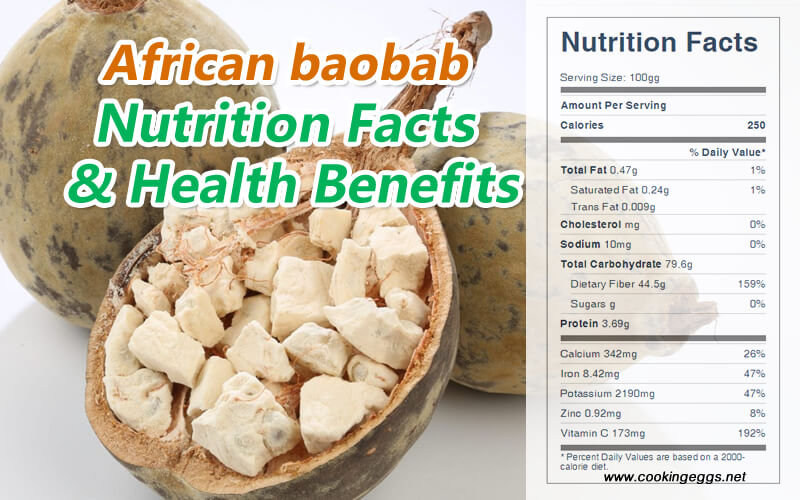Baobab Fruit Nutrition Facts & Health Benefits
African baobab is a common, multifunctional tree native to Western Africa's arid and semi-arid regions. The fruit of the baobab tree is the most useful part of the tree. The leaves and fruits, as well as being eaten, have been used for numerous medicinal purposes. The bark is also commonly used in medicines. The fruit pulp is rich in vitamin C and is widely used in Africa to combat scurvy-related diseases.
The baobab is also known as the upside-down tree, a name that originates from several myths. It is also known as the dead rat tree, Ethiopian sour gourd, Judas’s bag, magic tree, chemist tree, lemonade tree, symbol of the earth, monkey-bread tree, monkey tamarind, Senegal calabash, and cream of tartar, etc.
Traditionally, Africans have eaten the baobab fruits and made refreshing drinks from the juice. The pulp in particular is consumed by pregnant women and young children for its calcium content. The pectins are important as dietary fiber. The fruit pulp is also cooked, and the dried pulp can be used as an alternative to cream of tartar in baking. The unique chemical properties of baobab fruit pulp have led to its sale in US dispensaries and as cosmetics and care products in Canada. Medicinally, the baobab tree is important in traditional folklore for the treatment of dysentery and dehydration and is used to reduce fever.
The African baobab seeds can be consumed in their fresh state or ground into a flour that can be used in soup or stew preparations as thickeners. The baobab powder can be dissolved in water or milk to give a drink with a characteristic flavor resembling grapefruit, pear, or vanilla flavors. Industrially or at home, the pulp of baobab can be used as a thickener in the preparation of different kinds of beverages, including smoothies, juice, jams, and ice cream, while the fruit can also be used as a curdling agent. The pulp has found application as a seasoning in traditional dishes and can also serve as an appetizer. The fruit can also serve as a supplement to complement other staple foods like cornmeal. African baobab pulp, obtained from the fruit, has found use as a substitute for the cream of tartar due to the presence of citric and tartaric acids in the pulp.

The utilization of African baobab leaves is common amongst African folks, especially the inhabitants of the central regions of Africa, serving as a source of food. The immature leaves are usually cooked and used in foods similar to spinach. They can also be dried, ground, and used as sauces in porridge, thick gruels of grains, or rice.
Nutritional Value of Baobab Fruit
Nutritional analysis has shown that baobab fruits are an excellent source of pectin, calcium, vitamin C, and iron. Baobab fruit is a good source of vitamin C, potassium, carbohydrates, and phosphorus. The dried fruit powder of baobab contains about 11% water, 80% carbohydrates (50% fiber), and modest levels of various nutrients, including riboflavin, calcium, magnesium, potassium, iron, and phytosterols, with low levels of protein and fats. The kernels of the fruit are a good source of energy, protein, fat, calcium, potassium, and magnesium. The leaves are rich in calcium and protein as well as vitamins A and C.
Baobab Powder Nutrition Facts Label
Health Benefits of Baobab Fruit
There are several medicinal benefits of African baobab. The root, bark, and leaf extracts (methanic extracts) have high antiviral and antimicrobial activities. The bark contains the alkaloid Adansonin, studied to be active against malaria and fever. The fruit pulp is used as a functional food for the natural treatment and prevention of hyperlipidemia and associated health anomalies by enhancing the activity of the antioxidant enzymes.
The African baobab flower is also an edible part of the tree. The flowers have been used as a source of food with high protein content. The use of African baobab flowers also extends to religious activities, including offerings, ritual objects, shrine decorations, spiritual symbols, and garlands, to mention but a few.
African baobab fruit pulp can be used as a functional food for the natural treatment and prevention of hyperlipidemia and associated health abnormalities by boosting the activities of antioxidant enzymes.
The root, bark, and leaf extracts (methanic extracts) have shown high antiviral and antimicrobial activity. The bark contains an alkaloid called adansonin that is thought to be active against malaria and fever.
Baobab fruit is high in calcium. Calcium is well known for its function in maintaining bone and tooth health, but it is also critical to cell signaling, blood clotting, muscle contraction, and nerve function. Baobab fruit also contains phosphorus. Calcium and phosphorus are required to form the density of the bones and prevent osteoporosis. These minerals are also needed to maintain the density of dental enamel.
Baobab is a fruit that has long been used as a digestive aid because it contains both soluble and insoluble fiber. These types of dietary fiber are fantastic for the body because they improve digestion, reduce gut inflammation, control blood sugar and insulin levels, and even cut bad cholesterol, which is great for heart health. Additionally, the baobab fruit has certain prebiotic qualities that help boost digestion and increase gut bacterial populations.
Baobab is a good source of vitamin C. The immune system-boosting potential of this fruit is definitely a result of the high ascorbic content. Baobab is good for tissue repair, the formation of collagen, and the enzymatic production of certain neurotransmitters, in addition to vitamin C’s antioxidant behavior.
Another significant mineral found in the baobab fruit that is considered good for heart health is potassium. Vasodilators like potassium, which widen blood vessels and arteries to increase blood flow and prevent the heart from working too hard, serve to lessen the stress on the cardiovascular system. The prevention of atherosclerosis, strokes, heart attacks, and other cardiovascular problems can be helped by lowering blood pressure.